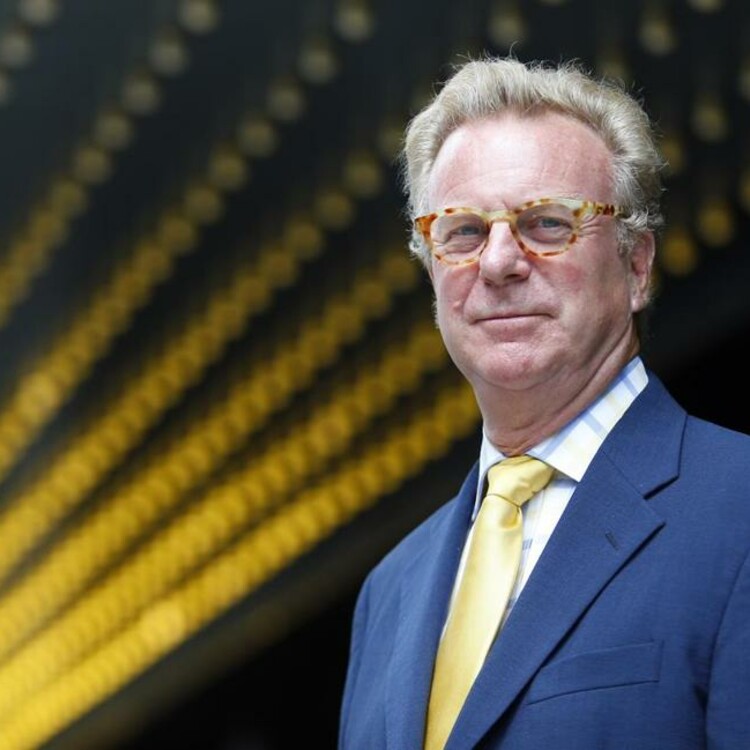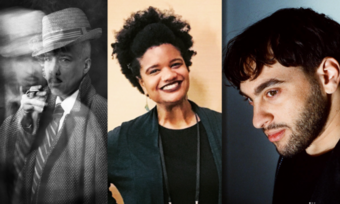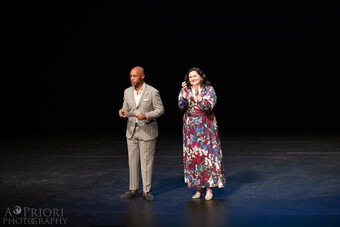The Center for the Theater Commons
Why Emerson? Why Now?
I’ve been asked to reflect on The Center for the Theater Commons: why Emerson; why now; what’s the level of professional engagement?
Before attempting answers to these questions, I want to celebrate what Arena Stage has done to bring us all to this juncture. It’s Arena’s originating vision and hospitality that launched many of the programs of the Theater Commons. As one of our flagship theaters, it provided the leadership to begin this effort, and that same leadership had the strength to see the value in this new association. Thank you, Arena Stage. And, thank you as well to The Andrew W. Mellon Foundation for its foundational funding.
I’ve been the chief administrative officer of two theaters working in collaboration with leading universities: The Yale Repertory Theatre from 1973 to 1979; and the American Repertory Theatre (A.R.T.) from its founding in 1979 in association with Harvard, until my retirement 30 years later in 2009. Between the two, I’ve had the distinct privilege of producing premieres by many of this country’s leading writers, and working with directors, designers, actors, composers, musicians, choreographers, technicians, administrators, agents, dramaturges, teachers, students, and coaches from this country and abroad—all of whom were exploring the boundaries of this constantly evolving and glorious art form we call theater.
I can’t imagine a better academic focus to activate the future of live performance through production, study, and research.

On October 1st, 2009, I began a new job as Executive Director of the recently formed Office of the Arts at Emerson College in Boston. I had no intention of taking on another full-time position—quite the contrary. At the age of 63, I was focused on changing the metabolism of my daily routine and traveling with my wife who had just retired, writing, reading, and advising and consulting on selected projects. The last thing I had in mind was leading a start-up entity and going from the usual 24/7 rhythm of the A.R.T. to what my wife aptly describes as the 36/10 demands of today.
But, I love the city of Boston. From the age of 12, it has been my city, my shot of urban energy, and the orbit around which my theater instincts circled and matured. So when Emerson College called on the day my retirement from the A.R.T. was made public and asked if I would come by for a tour and a talk, I gulped and said “yes.” Emerson had always been a college I admired and respected. Hard not to if you have an interest in the arts and communication.
The tour began with the opportunity to see the College’s now fully restored Cutler Majestic Theatre: a beautiful 1903, 1,200–seat Beaux Arts opera house. I had presented Philip Glass and David Henry Hwang’s 1000 Airplanes On the Roof in the same space when only partially restored in 1991. The company used temporary trailers we brought in and parked behind the building. There were no dressing rooms. Now, not only are there dressing rooms, but in the new, eleven-story tower Emerson College built behind and attached to the theater, there is a 250–seat ¾ round theater, a 100–seat fixed studio theater, and numerous support facilities including a magnificent costume shop.
After the tour of the 1,200–seat Cutler Majestic Theatre, we went on a hard-hat exploration of the yet-to-be-completed-but-pretty-far-along Paramount Center on lower Washington Street, just a couple of blocks from the Cutler on the edge of historic Boston Common in the city’s official Theatre District. The Paramount was originally a 1,100–seat movie palace built in 1933. It had been empty since 1976 and Emerson acquired not only the distressed theater, but also the building next door and a generous plot of land behind.
The space dedicated to the original 1,100–seat movie palace had been gutted and reconfigured into a 600–seat proscenium theater with a trapped stage, orchestra pit, and fly tower. The seating was divided roughly in half between the orchestra and the balcony. Happily, it works as both a 300-seat venue when playing more intimately only to the orchestra, and a full-capacity theater when opening up to the balcony.
In addition, the Paramount Center included an infinitely flexible black-box theater seating up to 150; a 170–seat, state-of-the-art cinema (also capable of hosting modest spoken word, live performances); a Hollywood style soundstage; nine rehearsal studios (three of which could function as modest 100–seat performance venues); numerous small practice rooms; commodious public lobbies; and a 5,000-square-foot scene shop.
Soon, they said, Emerson would also break ground on a new campus in Los Angeles (which is now under construction and slated to open in 2014). A facility in Hollywood, as well as the College’s campus in the Netherlands, simply added to the allure and sense of possibility.
At the end of the tour, I was asked if I wanted to program the three public theaters in the Paramount Center and the larger Cutler Majestic Theatre. I was told an Office of the Arts had been formed to manage and program these four spaces. And that the programming needed to be professional work engaged with the College and available to the public. It was structured to report directly to the President. I subsequently met with members of the Board and faculty, took the job, and retired from the A.R.T. on September 30th, 2009—one day before beginning my new responsibilities at Emerson on October 1st.
Here’s why.
Emerson has branded itself as: “a college that brings innovation to communication and the arts.” Its focus is on theater, film, video, journalism, marketing, communication disorders, writing, literature, and publishing in a liberal arts context. I can’t imagine a better academic focus to activate the future of live performance through production, study, and research. And, let’s not forget the glorious energy and shifting aesthetic impulses of a creative undergraduate population continually questioning and reinventing of the future of the form.
At Yale, the university has eminent graduate schools in art, architecture, music, and drama. The arts are central, but the graduate schools dominate.
At Harvard, it didn’t take thirty seconds, much less thirty years, for me to understand that the approach to the arts in Cambridge is largely extracurricular and thus recreational. Students can’t major in theater. There are no graduate degrees in the making of art, except as it relates to architecture and urban planning. Harvard, in short, has never fully embraced the arts as worthy of academic pursuit. In spite of having magnificent individual faculty dedicated to the arts, the structures aren’t in place to help them balance the dominating level of discourse on theory into an equal dose of attention to practice. Indeed, the University has a hard time using the word “art.” The undergraduate program in which students get to paint is in the Department of Visual and Environmental Studies. And, when Harvard realized in the late 1950s that in order to compete with Yale it needed to have a legitimate theater in which to perform plays, it built the Loeb Drama Center. It’s a “drama center” not a theater. Indeed, the competition with Yale came about by the departure in the 1920s of legendary Harvard playwriting professor George Pierce Baker to Yale because Harvard refused the gift of a theater Baker had lined up from Edward Harkness. So, when Baker decamped for Yale, he brought along the Harkness gift and built the University Theatre and established the Yale School of Drama. Thirty-five years later, Harvard built a theater in 1961, in the absence to this day of a degree–granting graduate school much less an undergraduate theater major. In yet another delicious historical footnote, the lonely, visionary Harvard Dean who was inspired in the 1950s to build the Loeb Drama Center, McGeorge Bundy, is the father of James Bundy, a graduate of Harvard College and the Yale School of Drama—now the distinguished artistic director of the Yale Repertory Theatre and Dean of the School of Drama.
Putting aside their varying attitudes about undergraduate education in theater, both Yale and Harvard have made magnificent contributions to the art form by supporting the work of the Yale Repertory Theatre and the A.R.T. Yale has more successfully aligned its investment to both undergraduate and graduate education. Pedagogically, Harvard has yet to design the structures to take full advantage of its investment.
I mention this history because Emerson has no such ambivalence. As a college of innovation in communication and the arts, it has a core commitment to the values and programs of the Center for the Theater Commons.
The students who choose Emerson generally do so with a high degree of certainty about what they want to do professionally and how the resources of the College feed their appetite. They are, in short, motivated, hungry, and incredibly creative.
Emerson faculty are, for the most part, active practitioners in the disciplines in which they also excel as teachers. The students who choose Emerson generally do so with a high degree of certainty about what they want to do professionally and how the resources of the College feed their appetite. They are, in short, motivated, hungry, and incredibly creative. Twenty-four hundred students now live in the Theatre District (Emerson’s home neighborhood), and walking the streets is a generational shot in the arm of youthful, creative curiosity. You can tell that these students are makers of art. They get their hands dirty taking risks, railing against perceived wisdom and exuding the certainty of youth that their way will be the future way. And, of course, they are right.
This is what appealed to me about Emerson and why I am certain that the Emerson culture is perfectly matched to the ideals of the Center for the Theater Commons.
Before I accepted the job at Emerson late in 2009, I articulated the values for professional presenting and producing that I felt would connect with Emerson’s mission and ambition.
To do it, we created ArtsEmerson: The World On Stage within the new Office of the Arts (OOA), animated by three operating assumptions:
1) Opening up the creative landscape of Boston to new work from this country and abroad that likely would otherwise never be seen in the community.
2) Making a constantly rotating multi-year commitment to artists and organizations. To say to artists, “we will do your work; we will introduce your particular signature to audiences so they can see it evolve over time”, and;
3) Helping in the creation of work. To be generative—to be known as a place where new work is developed as well as performed. ArtsEmerson’s first season opened in September 2010. We are now nearing the end of our second season. We have established partnerships and worked with Elevator Repair Service (ERS), the Foundry Theatre, The Civilians, T.E.A.M., Tectonic Theatre, Universes, The Abbey Theatre, 7 Doigts, 4Darts, SITI Company, Sulayman Al-Bassam Theatre, Robert Lepage, Druid Theatre, New York Theatre Workshop, Martha Clarke, Theatre for a New Audience, Laurie Anderson, Gare St. Lazare Players, Robbie McCauley, The Rude Mechs, Basil Twist, Doug Elkins, Peter Brook, and Guillermo Caulderón, among others.
Since September of 2010, there have been professional artists in residence at ArtsEmerson for more than fifty-five weeks, developing and/or presenting their work and engaging with the College and the greater Boston community.
It’s this concentration and variety of artists and cultures that I believe serves the Center for the Theater Commons well. The artists ArtsEmerson brings to the community feeds the Commons’s appetite for examining diverse structures and working methodologies; the work that ArtsEmerson presents to the public serves as a laboratory for The Commons’s inquiry into audience development, research, and community engagement. And, what organization wouldn’t die to have David Dower, Polly Carl, Jamie Gahlon, and Vijay Mathew in their midst.
For forty-six years, my professional life has been centered without stop on serving theater artists, the public, and the next generation of talent. I have never felt more excited about the future of theatre than I do today. I have also never had as much anxiety about how that future is being served. The Center for the Theater Commons will help us all explore the landscape of possibilities.
Emerson locates itself as the Campus on the Common. By which it means Boston Common, the oldest public park in the United States. The park’s existing pathways were carved out 375 years ago by the cows that grazed unencumbered by tradition or precedent throughout its acreage. The Center for the Theater Commons is providing the same freedom for today’s theater workers to similarly graze and mark the territory with their own lasting sense of direction. It’s an honor to be able to participate.














Comments
The article is just the start of the conversation—we want to know what you think about this subject, too! HowlRound is a space for knowledge-sharing, and we welcome spirited, thoughtful, and on-topic dialogue. Find our full comments policy here